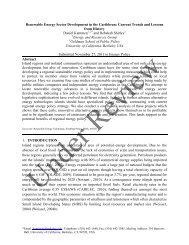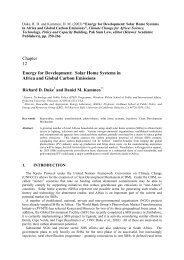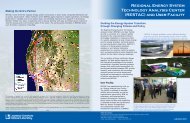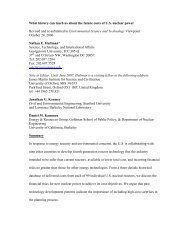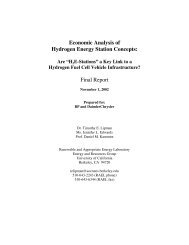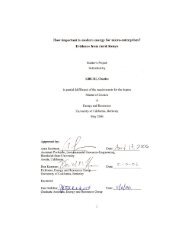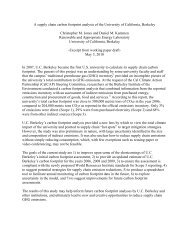Testing Small Wind Turbine Generators - Renewable and ...
Testing Small Wind Turbine Generators - Renewable and ...
Testing Small Wind Turbine Generators - Renewable and ...
- No tags were found...
You also want an ePaper? Increase the reach of your titles
YUMPU automatically turns print PDFs into web optimized ePapers that Google loves.
To ensure that connections remain secure throughout potentially vibration-prone testing,split-ring lock washers are used with every fastener.2.3 Drivetrain2.3.1 TheoryWhen the dynamometer is running, It is essential for both electrical machines <strong>and</strong>the encoder to rotate exactly synchronously.If the generator alone turns at a differentdifferent angular velocity, the speed measurement developed by the encoder <strong>and</strong> digitalsignal processor will inaccurately reflect the true speed of the generator. Worse still, if theencoder <strong>and</strong> motor get out of sync the motor will stop turning smoothly, jerk to a halt, ormove erratically with potentially dangerous torque <strong>and</strong> current.Thus a belt <strong>and</strong> pully system would be inadequate. Belts can have a tendency to slip(suddenly losing traction) <strong>and</strong> creep (slowly advancing one pulley faster than another).Chain drive systems, however, guarantee sychronous motion by engaging discrete chainlinks on the teeth of a sprocket. As long as each sprocket has the same number of teeth <strong>and</strong>the chain does not fail, the motion of each component will remain synchronous indefinitely.2.3.2 DesignThe generator shafts are designed for an attachment to be bolted on, compressed betweenthe thick main shaft <strong>and</strong> a nut on the thinner, threaded end of the shaft. The threadis an unusual metric size: 20 mm in diameter, with a 1.5 mm pitch. Thus to fit the shafts,flat sprockets with a 5/8” (15.9 mm) bore were machined on a lathe to have the required20 mm bore. Figure 2.6 shows a sprocket mounted on the generator shaft.The shaft of the optical encoder is 1/4”, far too small for any st<strong>and</strong>ard sprocket. Thisproblem was solved by increasing the diameter of the shaft with aluminum shaft couplings.These inexpensive units attach with set screws, <strong>and</strong> are adequate for the low torque appliedto the encoder. One coupling has an inside diameter of 1/4” <strong>and</strong> <strong>and</strong> outside diamter of12




